Ever dreamed of transforming your kitchen into a warm, inviting haven that feels like the heart of the home? Farmhouse kitchen design has surged in popularity because it effortlessly combines rustic charm with modern comfort, creating a space that’s both cozy and stylish. Its timeless appeal lies in its ability to blend vintage touches with functional practicality, making every meal prep feel like a comforting tradition.
In this article, you’ll discover a treasure trove of inspiring ideas and practical tips to elevate your farmhouse kitchen. From charming vintage lighting to textured textiles and clever storage solutions, these design elements will help you craft a space that exudes warmth and personality. Whether you’re starting from scratch or adding a few touches, get ready to explore diverse styles and creative tricks that will bring your farmhouse kitchen dreams to life!
1. Reclaimed Wood Beams and Accents for Rustic Charm
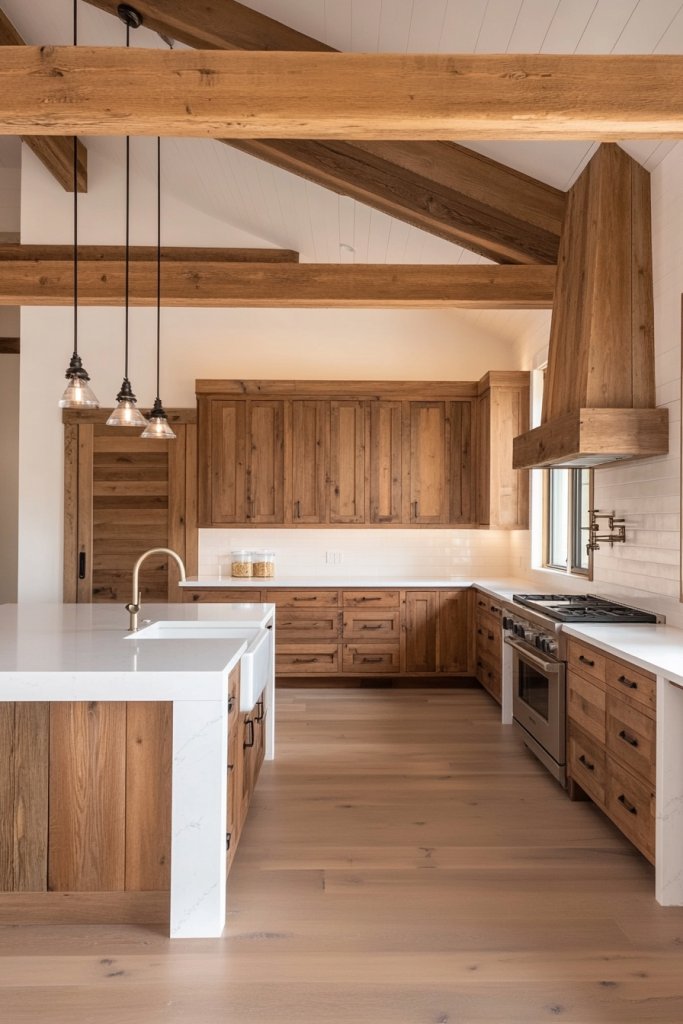
Adding reclaimed wood beams and accents instantly infuses your farmhouse kitchen with authentic rustic charm, creating a warm and inviting atmosphere. This feature not only highlights the farmhouse aesthetic but also adds a layer of visual interest and texture to the space, making it feel grounded and timeless.
Imagine exposed, weathered wooden beams spanning the ceiling, their rich, natural grain and knots adding character and depth. Accent panels or open shelving made from reclaimed wood can be paired with vintage metal brackets, providing a balanced mix of rough-hewn charm and functional design.
The warm, earthy tones of the wood—think honey, oak, or deep chestnut—contrast beautifully with neutral wall colors like soft whites or gentle greys. This combination creates a space that feels cozy and lived-in, with a subtle nostalgic scent of aged timber enhancing the sensory experience.
To incorporate this look, start by sourcing reclaimed or distressed wood from local suppliers, vintage stores, or online marketplaces. For a DIY approach, carefully remove and clean the wood, then have it cut to size for beams or accents.
Secure the beams to your ceiling with appropriate anchors, ensuring they are level and safely installed. For accents, consider installing floating shelves or paneling, attaching them with sturdy brackets.
Keep the finish natural or add a light protective sealant to preserve the weathered appearance. This straightforward upgrade transforms your kitchen into a warm, rustic retreat.
2. Vintage-Inspired Pendant Lighting for a Cozy Glow

Vintage-inspired pendant lighting is essential for creating a warm, inviting glow that complements a farmhouse kitchen’s cozy, nostalgic vibe. Carefully chosen fixtures evoke a sense of history and craftsmanship, casting soft light that enhances the space’s charm and functionality.
Picture a cluster of antique bronze or distressed black pendant lights hanging over a central island or dining area. The shades might be made of metal, glass, or ceramic, with finishes that appear aged or weathered, such as matte black or brushed nickel.
The warm glow from Edison-style filament bulbs adds a subtle amber hue, creating a relaxing ambiance perfect for family dinners or quiet mornings. The scale of the fixtures—large enough to make a statement but not overpowering—adds visual interest, while the textured surfaces and vintage detailing evoke a sense of timeless craftsmanship.
For easy installation, choose pendant lights with adjustable cords or chains to tailor the height to your ceiling and workspace needs. Look for fixtures that feature vintage or industrial design elements, like exposed bulbs, ribbed glass shades, or antique metal finishes.
Pair these with warm-white Edison bulbs or filament LED bulbs for energy efficiency. Mount the fixtures securely, ensuring electricity safety codes are followed. Whether shopping at vintage stores or modern retailers, selecting fixtures with a distressed or aged finish will perfectly evoke a farmhouse aesthetic, adding warmth and character to your kitchen.
3. Open Shelving with Mason Jars and Crocks
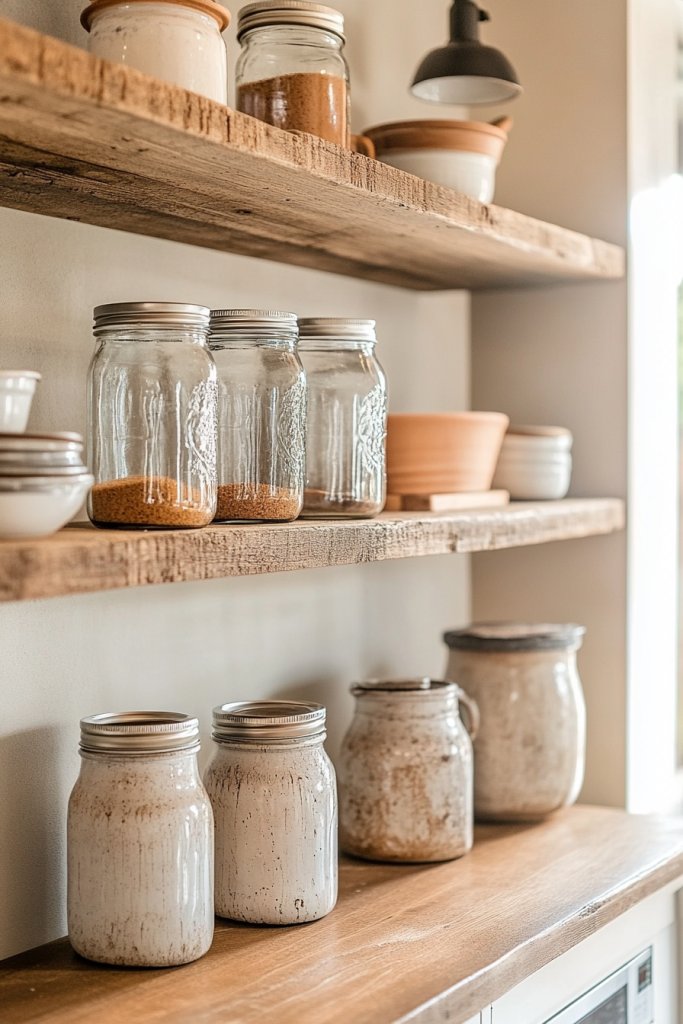
Open shelving adorned with mason jars, ceramic crocks, and vintage containers is a hallmark of farmhouse kitchens, blending practicality with decorative charm. This display method offers easy access to essentials while showcasing your favorite rustic accents.
Visualize sturdy wooden shelves mounted on the wall, stained in a light or distressed finish, holding an array of glass mason jars filled with dried herbs, grains, or colorful candies. Ceramic crocks in muted tones like cream or soft blue sit alongside vintage metal or wooden containers, adding texture and visual contrast.
The open arrangement allows you to see every item at a glance, adding an inviting, homey feel to the space. The display not only enhances functionality but also acts as a charming decorative element, giving your kitchen a curated, lived-in vibe that’s full of personality.
To implement, start by installing simple, sturdy wooden shelves using brackets or floating shelf hardware, ensuring they are level and securely anchored into wall studs. Source mason jars and crocks from thrift stores, antique shops, or online marketplaces—look for authentic vintage pieces or modern reproductions with rustic finishes.
Organize your items by type or color for visual appeal, and consider adding labels or tags for extra charm. Keep the shelves tidy and rotate items seasonally or as needed, transforming everyday storage into a delightful display that celebrates farmhouse simplicity and practicality.
4. Classic Subway Tile Backsplash with Warm Tones
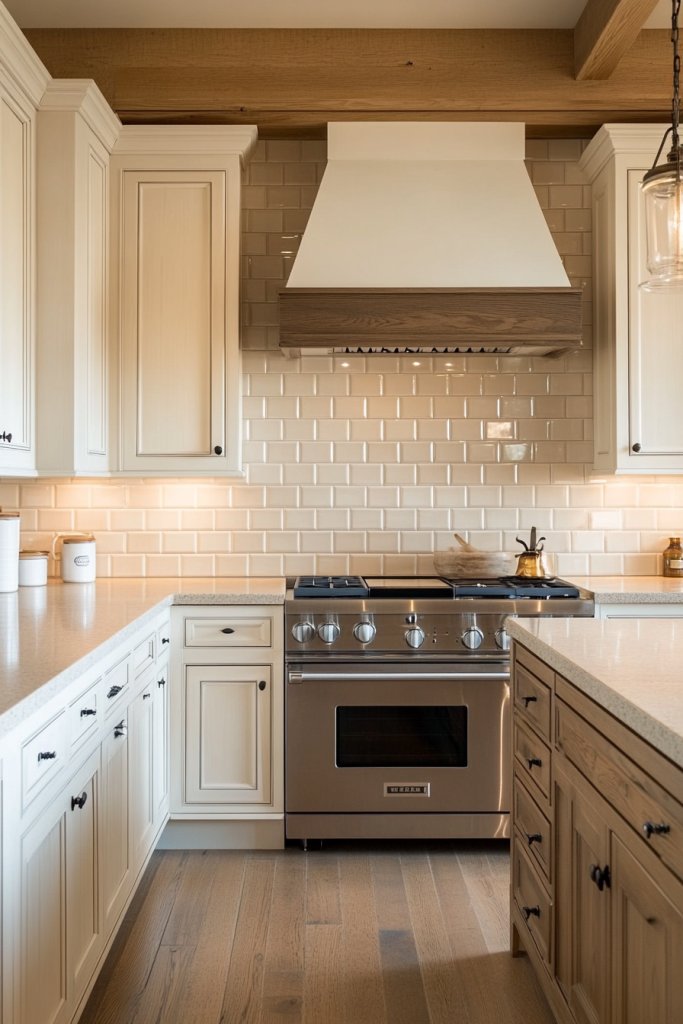
A classic subway tile backsplash in warm, neutral tones is a timeless yet versatile choice that adds texture and brightness to your farmhouse kitchen. Its clean lines and understated elegance serve as a subtle backdrop for other rustic accents, tying the space together beautifully.
Picture rectangular subway tiles in shades like creamy ivory, soft beige, or warm taupe laid in a traditional brick pattern. The glossy surface reflects light, making the room feel brighter and more spacious.
The warm hues complement natural wood elements and vintage fixtures, while the textured grout lines add a handcrafted feel reminiscent of old-world charm. This combination creates a balanced, inviting environment where cooking and gathering feel effortless and cozy.
To install, prepare your wall by cleaning and leveling the surface. Use standard ceramic or porcelain subway tiles, which are widely available at hardware stores and online.
Mix a warm-toned or neutral grout to match the tiles, and apply with a rubber float, ensuring even coverage. For a DIY project, follow detailed tutorials to achieve precise, clean lines.
Seal the grout after curing for longevity and ease of cleaning. This simple yet classic update elevates your farmhouse kitchen with timeless style and warmth, serving as a beautiful backdrop for all your culinary moments.
5. Farmhouse Sink with Traditional Detailing
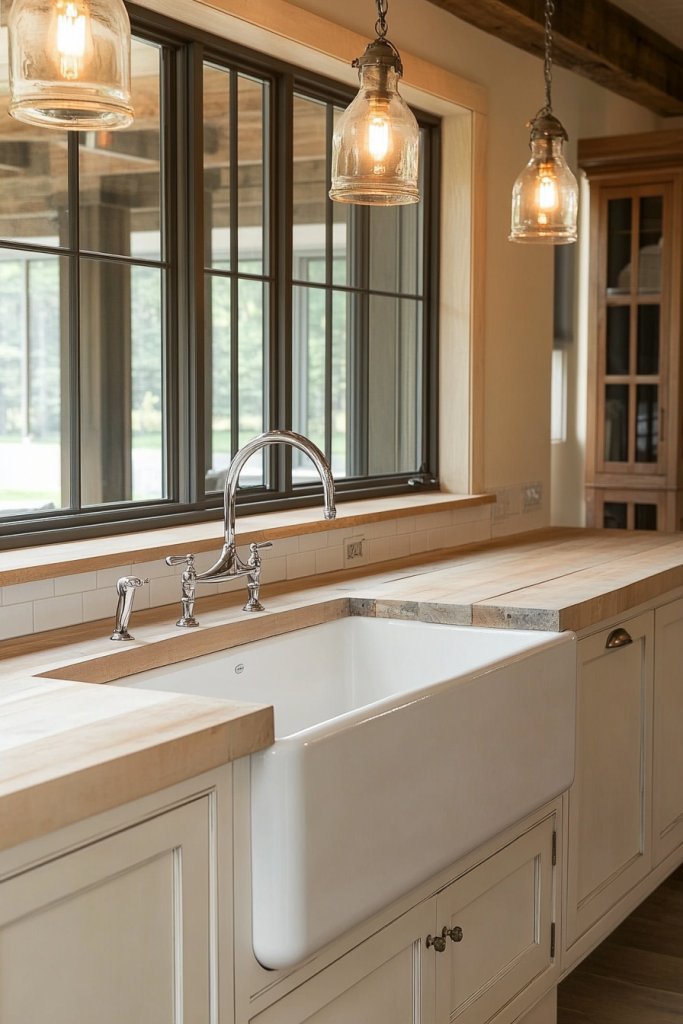
A farmhouse sink, also known as an apron-front sink, is the centerpiece of a farmhouse kitchen, combining practicality with nostalgic charm. Its oversized, deep basin and decorative front panel embody timeless farmhouse style and functionality.
Imagine a large, white ceramic or fireclay sink with a gently curved apron that extends slightly beyond the countertop. Traditional detailing might include beveled edges or subtle decorative ridges, paired with vintage-inspired fixtures like black iron or oil-rubbed bronze faucets.
The sink’s generous size makes it perfect for washing large pots or handling big family meals, while its classic appearance adds warmth and character to the space. The combination of smooth, durable materials and timeless design evokes a sense of history and craftsmanship, making it both a functional and aesthetic focal point.
To incorporate this feature, select a farmhouse sink that fits your space and style—ceramic, fireclay, or even stainless steel with a vintage finish. Measure your cabinet opening carefully and choose a model that provides ample depth and width.
Install the sink with proper plumbing connections, ensuring a secure fit and leak-proof operation. Add vintage-inspired fixtures, such as cross-handle or pull-down faucets, to complete the look. Whether shopping at specialty kitchen retailers or vintage suppliers, a farmhouse sink instantly elevates your kitchen’s charm while offering unmatched practicality for everyday use.
6. Distressed Wooden Furniture and Kitchen Islands
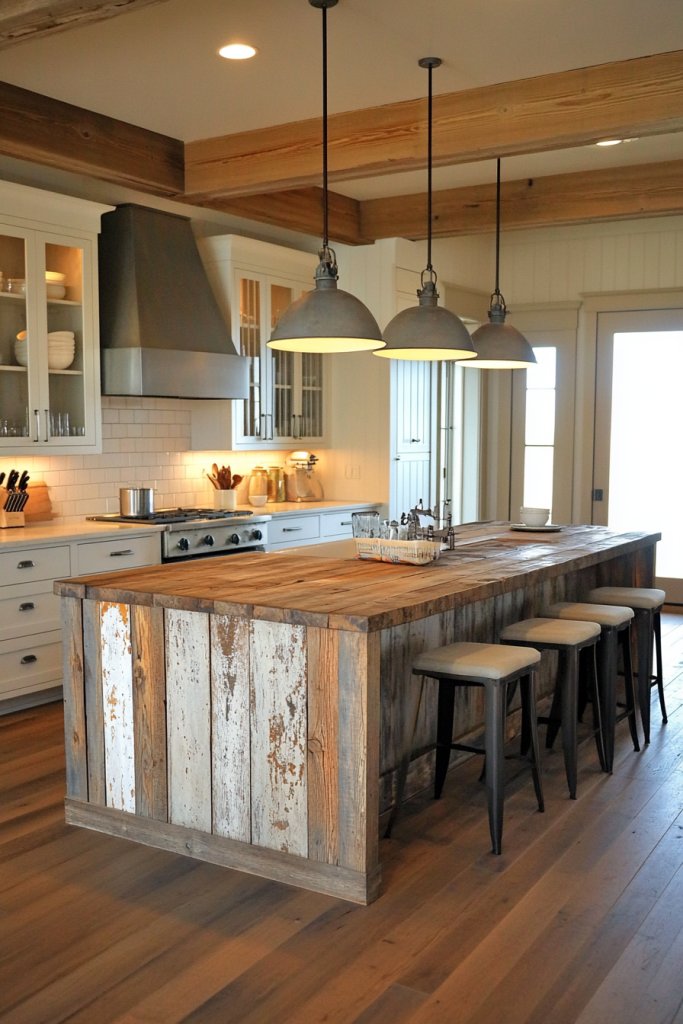
Adding distressed wooden furniture and islands instantly brings a warm, lived-in feel to your farmhouse kitchen, evoking a sense of history and coziness. These pieces often feature chipped paint, weathered surfaces, and a patina that tells a story, making your space feel authentic and inviting.
The rustic charm is amplified by natural wood tones like warm honey, soft gray, or faded white, which blend seamlessly with other farmhouse elements. Imagine a large wooden kitchen island with a rough-hewn surface, painted in a muted, pastel shade such as soft blue or creamy beige, with intentional signs of aging like chipped paint and uneven edges.
Pair this with matching distressed dining chairs or a weathered wooden table, textured with visible grain and imperfections that highlight craftsmanship. The tactile contrast between the rough wood and smooth ceramics or soft textiles enhances sensory appeal, creating a cozy, welcoming atmosphere.
To recreate this look, start with budget-friendly options like reclaimed wood or furniture with a distressed finish available at thrift stores or furniture outlets. Sand down certain areas to enhance the aged appearance, then apply a matte sealant for durability.
For DIY enthusiasts, lightly chipping paint with a scraper or using a vinegar wash can achieve the authentic weathered look. Combining these with simple, vintage-inspired hardware or a distressed paint technique will give your kitchen a charming, rustic upgrade that’s both practical and visually appealing.
7. Shaker-Style Cabinetry with Matte Finish

Shaker-style cabinetry is a cornerstone of farmhouse design, characterized by its simple, clean lines and functional elegance. When finished with a matte surface, these cabinets exude understated sophistication while maintaining a cozy, approachable vibe.
Soft, muted colors like sage green, warm gray, or creamy white enhance the subtle charm, creating a harmonious backdrop for other farmhouse details. Visualize sleek, square-paneled cabinets with minimal detailing, finished in a silky matte paint that absorbs light gently, reducing glare and adding a refined touch.
The handles are typically understated—antique brass or black iron pulls—complementing the muted palette. The overall effect is a balanced space that feels fresh yet timeless, with a focus on practicality and style.
The matte finish also helps hide fingerprints and smudges, making maintenance easier for busy kitchens. To implement this look, start with shaker cabinet doors from a trusted supplier or paint existing cabinets with high-quality matte paint in your chosen color.
For a DIY approach, lightly sand the surface before applying a primer and two coats of matte finish paint, ensuring even coverage. Add vintage-inspired hardware for a subtle farmhouse touch. These cabinets serve as a versatile foundation that pairs beautifully with open shelving, rustic hardware, and soft textiles, creating a welcoming yet polished farmhouse kitchen.
8. Neutral Color Palette with Soft Accents

A neutral color palette is the heart of farmhouse kitchen design, establishing a calm, cohesive environment that feels inviting and versatile. Whites, creams, and light grays serve as the perfect canvas, allowing decorative accents—like soft pastel or muted hues—to stand out without overwhelming the space.
This approach emphasizes simplicity, light, and a timeless aesthetic. Picture a kitchen with pale beige walls, creamy white cabinetry, and light gray countertops, all harmonized with gentle touches like blush pink dish towels or pale blue ceramic bowls.
The overall color scheme creates a serene atmosphere that reflects natural light, making the space appear larger and more open. Textured elements such as linen curtains, woven baskets, and soft textiles add depth and tactile interest to the neutral backdrop, enhancing the cozy farmhouse feel.
To achieve this look, select paint colors in matte or eggshell finishes for walls and cabinetry to keep the tone soft and understated. Incorporate subtle accents through kitchen textiles, such as a plaid or gingham dish towel, or a soft blush throw pillow on nearby seating.
Keep accessories minimal and cohesive, focusing on natural materials like wood, ceramic, and linen. This palette offers a flexible base for adding seasonal decor or personal touches, ensuring your farmhouse kitchen remains fresh, inviting, and effortlessly charming.
9. Rustic Open-Frame Windows and Shutters
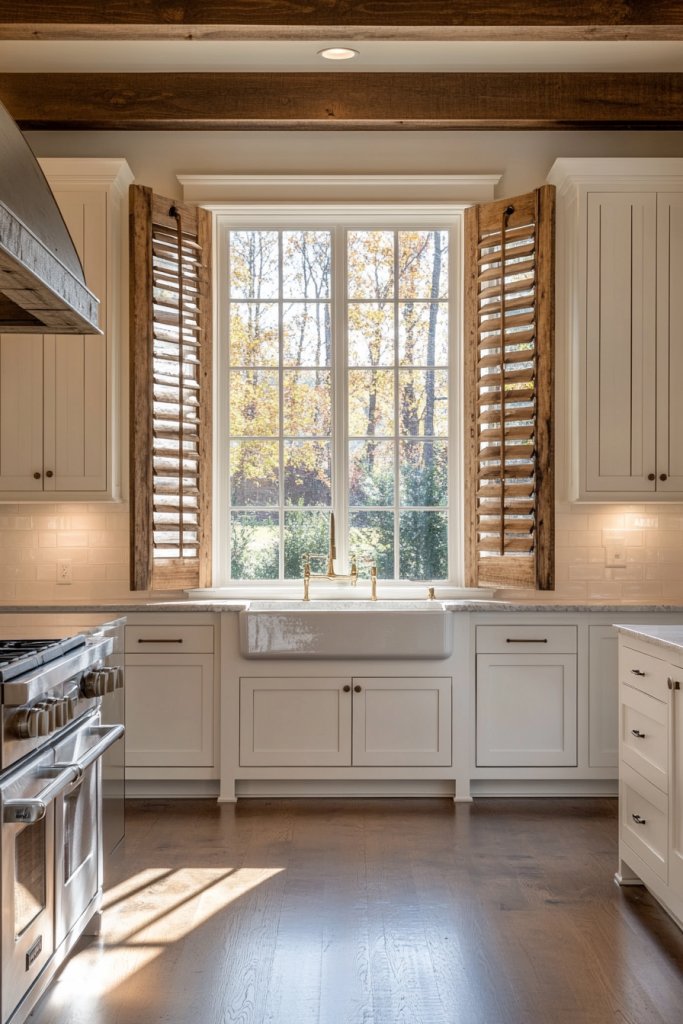
Rustic open-frame windows and shutters are both functional and decorative, adding architectural interest and a classic farmhouse charm to your kitchen. These elements bring in natural light, frame views beautifully, and introduce texture with weathered wood finishes that echo the rustic aesthetic.
Visualize a large window with a simple wooden frame, paired with charming, louvered shutters painted in soft white or muted barn red. The shutters can be left open to flood the space with sunlight or closed for cozy evenings, adding a layer of visual interest and historic appeal.
The weathered wood grain and imperfect finish of the shutters evoke a sense of age and authenticity, while the open-frame design emphasizes the farmhouse emphasis on light and airiness. To incorporate these features, consider sourcing reclaimed or distressed wood shutters from specialty suppliers or repurposing old window frames for a DIY project.
Mount shutters on either side of existing windows or install new open-frame windows in areas where structural modifications are feasible. Painting or staining the wood in soft, muted tones enhances the rustic look while protecting the material. These window elements not only brighten your space but also serve as charming focal points, anchoring your farmhouse kitchen’s timeless appeal.
10. Vintage-Style Kitchen Hardware and Fixtures
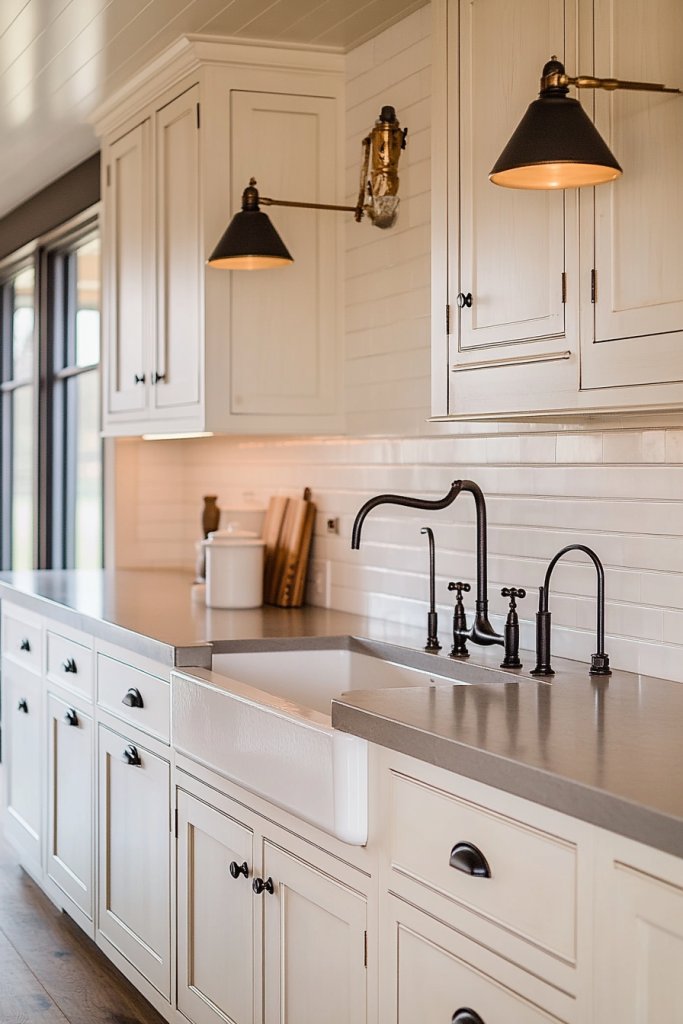
Vintage-style hardware and fixtures are the finishing touches that truly tie together the farmhouse aesthetic. Using antique brass, brushed nickel, or black iron handles, knobs, and faucets adds character, history, and a touch of industrial charm to your kitchen cabinetry and surfaces.
Imagine cabinet pulls in a distressed brass finish, with a rounded, vintage-inspired shape that feels both sturdy and timeless. Pair these with a rustic black iron faucet with a high-arc spout and cross handles, reminiscent of old farmhouses.
These details lend authenticity and elevate the overall look, creating a cohesive, curated feel that celebrates farmhouse tradition. To incorporate this style, swap out modern hardware for vintage-inspired options available at hardware stores or online marketplaces.
Choose fixtures with a matte or distressed finish for added rustic appeal. For an easy upgrade, use adhesive-backed labels or decorative plates to hide unsightly screw holes or mismatched hardware. These small but impactful details add a layer of craftsmanship and charm that enhances the overall farmhouse aesthetic, making your kitchen feel both stylish and historically rooted.
11. Textured Linen or Burlap Window Treatments
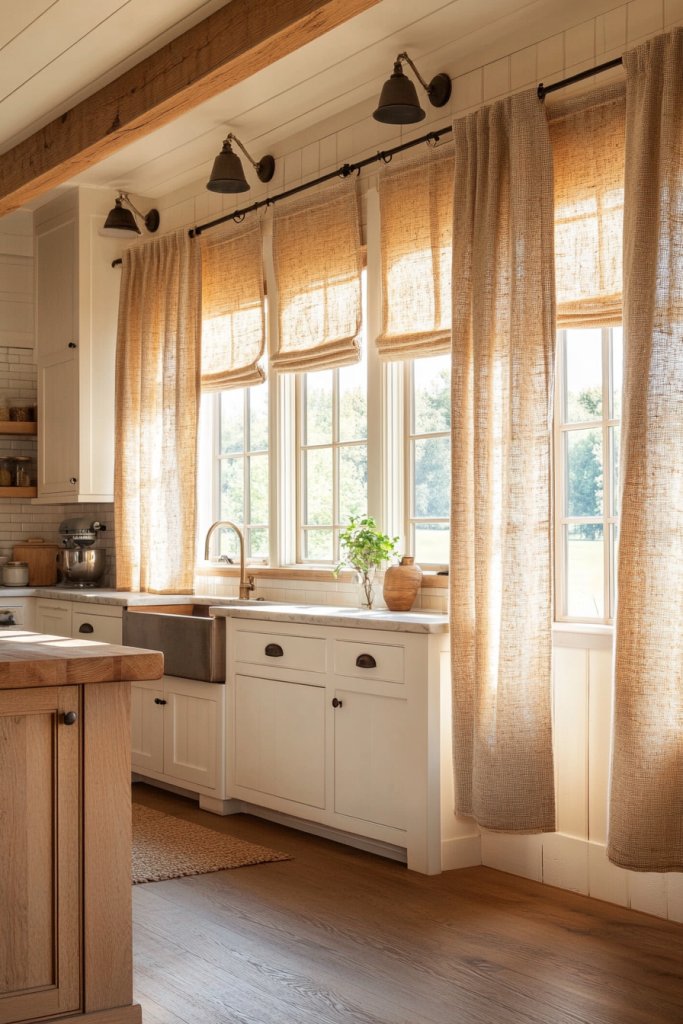
Adding textured linen or burlap curtains instantly infuses your farmhouse kitchen with warmth and a cozy, inviting feel. These fabrics bring a natural, rustic charm that complements wood accents and vintage details perfectly.
Their slightly coarse, woven surface adds visual interest and tactile richness, making the space feel layered and thoughtfully curated. Usually in soft neutrals like ivory, taupe, or warm beige, these textiles subtly reflect light, creating a gentle, ambient glow that enhances the overall rustic atmosphere.
Imagine a pair of lightweight linen curtains, slightly crinkled and casually hung over a large open window. The fabric gently sways with a breeze, releasing a faint, earthy scent that evokes a rural retreat.
Burlap options can be hung with simple, wrought-iron rods, adding a touch of rugged charm. The textured surface contrasts beautifully with smooth, painted cabinetry or sleek countertops, grounding modern elements within the farmhouse aesthetic.
These window treatments are versatile enough to suit both small, cozy kitchens and larger, open-concept spaces. To implement this look, start by choosing linen or burlap fabric in neutral tones.
Measure your windows carefully, allowing for a slightly gathered, relaxed appearance—about 1.5 times the width of your window for fullness. For a DIY project, purchase pre-cut fabric or repurpose old curtains, then attach them to a simple metal or wooden curtain rod using clip rings or rings with hooks.
For a polished finish, wash and lightly iron the fabric beforehand to achieve that soft, lived-in look. No sewing is necessary for basic panels—just use fabric clips or tiebacks to hold the curtains in place.
12. Decorative Wooden Trays and Crates

Decorative wooden trays and crates are charming, functional accents that bring a touch of rustic authenticity to your farmhouse kitchen. They serve as stylish storage solutions while adding warmth and texture to your space.
Whether used to display fresh baked goods, hold utensils, or organize spice jars, these wooden pieces create visual interest and a cozy, lived-in vibe. Their distressed or weathered finishes highlight the handcrafted, vintage appeal that defines farmhouse style.
Picture a large, shallow wooden tray with a natural or whitewashed finish, filled with a bundle of vintage-inspired dish towels, a ceramic pitcher, or a batch of freshly baked cookies. Crates stacked on open shelves or placed on the countertop hold everything from wine bottles to fruit, adding an organized yet casual look.
The rough-hewn textures and imperfect edges evoke a sense of history and craftsmanship, making the kitchen feel warm and welcoming. These elements also encourage a relaxed, family-friendly atmosphere perfect for everyday living or entertaining guests.
To create this look, select wooden trays and crates in various sizes—preferably with distressed, reclaimed, or weathered finishes for authenticity. You can find these at antique stores, craft markets, or online retailers, or even repurpose wooden boxes for a budget-friendly option.
Arrange them on open shelves, countertops, or island surfaces, filling them with practical or decorative items. For a DIY touch, lightly sand and stain or whitewash new wood, then seal with a clear matte finish for durability. These versatile pieces add character and function effortlessly.
13. Classic Ceramic or Glass Canisters and Jars
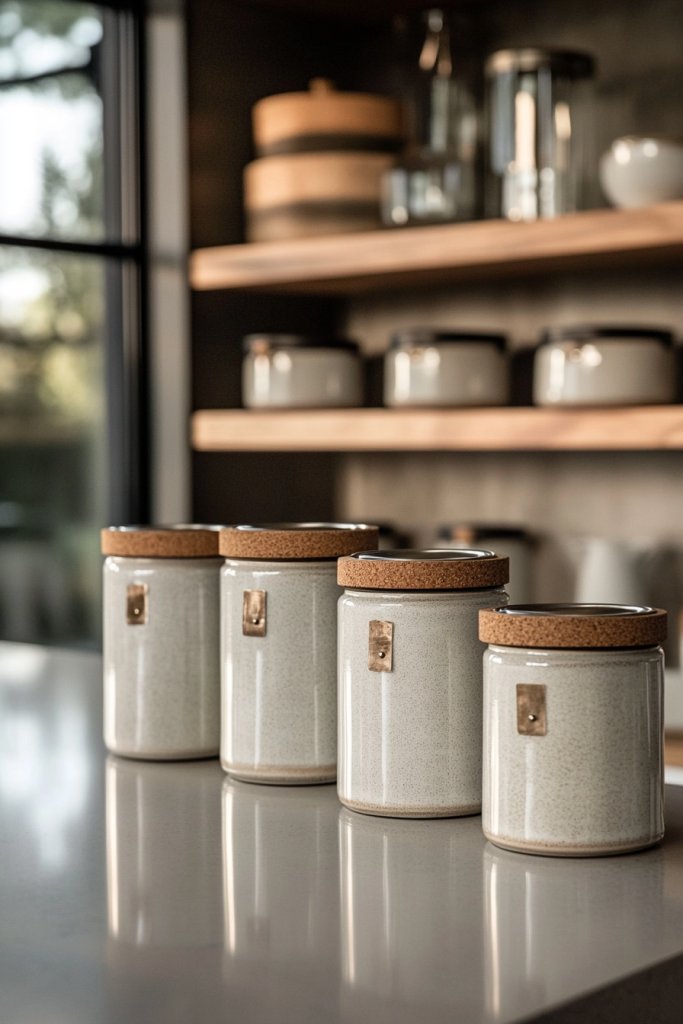
Using uniform ceramic or glass canisters and jars elevates your farmhouse kitchen’s storage while adding a vintage touch. They keep everyday staples like flour, sugar, coffee, and pasta neatly organized and easily accessible.
Their clear or frosted surfaces, paired with simple metal or wooden lids, evoke a nostalgic, old-world charm that complements the farmhouse aesthetic beautifully. These containers also serve as decorative accents on open shelves or countertops, enhancing the overall visual harmony.
Visualize a row of glass jars with airtight seals, filled with colorful dried pasta, beans, or baking ingredients. The transparent surfaces showcase the contents, adding pops of color and a sense of abundance.
Ceramic canisters in soft, muted hues such as cream, sage, or dusty blue sit neatly on a countertop, their minimalist designs blending seamlessly into the rustic decor. The uniformity of these containers creates a cohesive, curated look that feels both functional and charming.
Their vintage practicality makes everyday kitchen tasks more enjoyable and organized. To implement, gather ceramic or glass canisters with matching lids—look for options with simple, unadorned designs.
Measure your pantry space to determine appropriate sizes, and group similar items together for ease. You can find these at home goods stores, vintage markets, or online.
For a DIY approach, paint or stencil labels directly onto the jars for a personalized touch. Placing them in a designated open shelf or on a countertop creates an inviting, organized display that makes your kitchen both beautiful and practical.
14. Handmade Wreaths and Rustic Wall Hangings
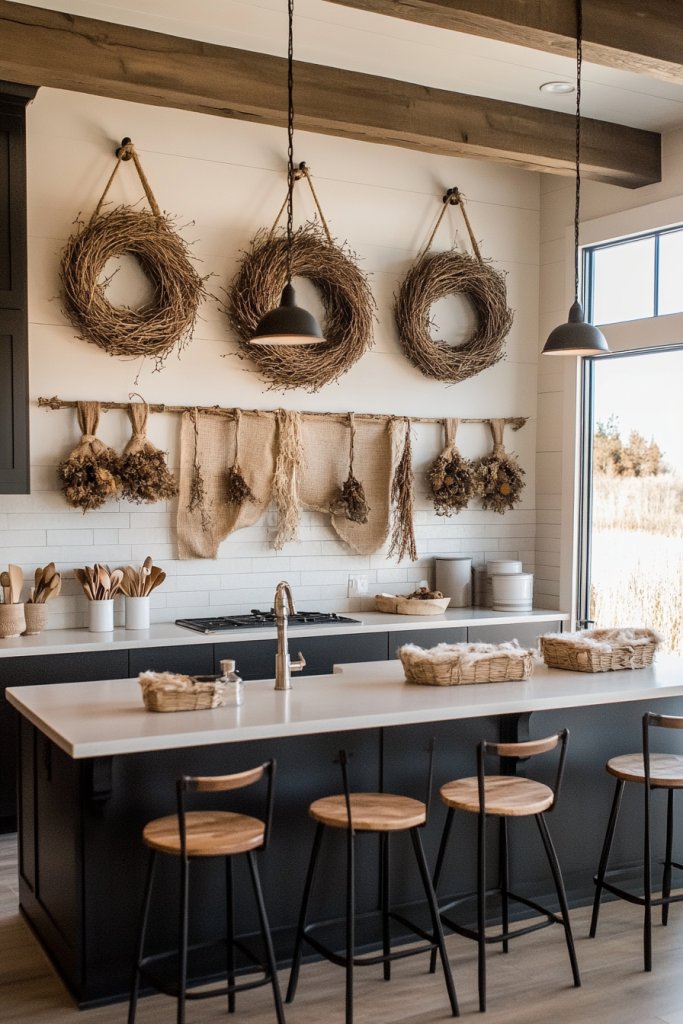
Decorating your farmhouse kitchen with handmade wreaths and rustic wall hangings infuses the space with personality and welcoming warmth. These handcrafted accents often feature natural materials like dried herbs, sprigs of lavender, burlap ribbons, or vintage fabric scraps.
They add a layered, textured aesthetic that emphasizes the cozy, nostalgic feel of farmhouse style. Whether hung over a doorway, above the sink, or on an open wall, these pieces serve as charming focal points that reflect your personal touch.
Picture a circular wreath made of intertwined grapevine or reclaimed wood, adorned with dried flowers, cinnamon sticks, and a burlap bow. Alternatively, a woven textile wall hanging with fringe details or vintage-inspired signs with hand-painted lettering can lend character and warmth.
These elements soften the space, making it feel more inviting and lived-in. They also provide opportunities to incorporate seasonal or holiday themes, enhancing the farmhouse charm year-round.
To create or acquire these decorations, start with simple wire wreath forms or reclaimed wood rings. Decorate with natural elements like dried herbs, faux berries, or vintage ribbon—using hot glue or twine for assembly.
For wall hangings, repurpose woven fabrics, vintage tea towels, or even quilted textiles, attaching them to a wooden dowel or branch. Hang these pieces with rustic hooks or twine for an authentic look. DIY projects are accessible and allow you to customize your decor to perfectly suit your farmhouse style.
15. Antique or Repurposed Kitchen Tools as Decor
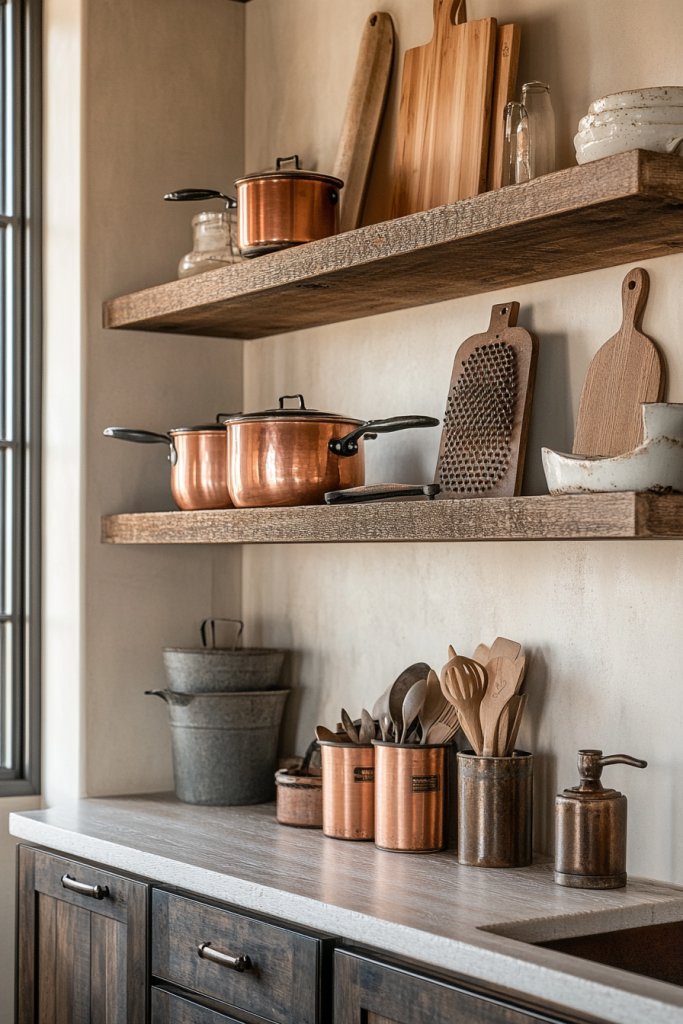
Showcasing antique or repurposed kitchen tools as decor adds a rich layer of history and craftsmanship to your farmhouse kitchen. Items like vintage rolling pins, copper pots, old-fashioned graters, or cast iron skillets can be displayed on open shelves, hung on walls, or arranged as centerpieces.
These pieces not only celebrate tradition but also serve as conversation starters, creating a warm, nostalgic atmosphere. Their rustic, worn finishes bring authenticity and charm that define the farmhouse aesthetic.
Visualize a collection of copper pots hanging from a wrought-iron rack above the stove, catching the light and adding a warm metallic glow to the space. Vintage rolling pins with painted or engraved handles are displayed on open shelves or mounted on the wall as decorative accents.
Old cast iron skillets arranged on hooks or stacked on shelves evoke a sense of heritage and durability. These tools, often with patinas and signs of use, tell stories of generations past, enriching your kitchen’s character and charm.
To incorporate these elements, source antique or vintage kitchen tools from flea markets, antique stores, or online marketplaces. Clean and lightly polish if needed, but preserve the aged look for authenticity.
Hang tools with sturdy hooks or mount shelves for display. For a DIY twist, repurpose old tools into creative wall art or functional decor pieces, like transforming a vintage rolling pin into a paper towel holder or utensil rack. These accents bring a sense of history and craftsmanship into your rustic kitchen environment, making it both functional and full of character.
16. Cozy Textiles: Plaid and Gingham Patterns
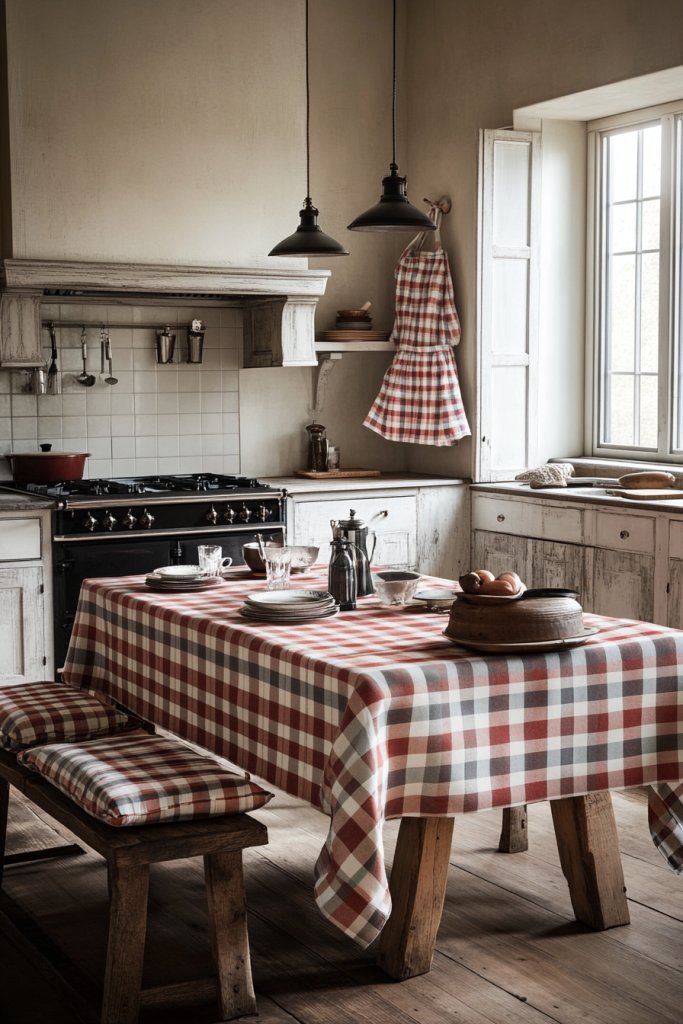
Adding cozy textiles like plaid and gingham patterns instantly brings warmth and charm to a farmhouse kitchen, making the space feel welcoming and lived-in. These classic patterns evoke nostalgic comfort, reminiscent of country cottages and family gatherings, perfect for creating a relaxed atmosphere.
Imagine a sturdy tablecloth in a red and white gingham pattern, its soft fabric slightly crinkled from use, or a set of dish towels with blue plaid stripes hanging casually from oven handles. Quilted seat cushions with bold checks or textured throw blankets draped over farmhouse chairs add tactile warmth, inviting you to settle in.
The textures vary from smooth cotton to chunky weaves, providing both visual interest and sensory comfort. These patterns work beautifully with natural wood tones, white cabinetry, and vintage-inspired ceramics, tying the entire look together in a cohesive, charming way.
To incorporate these textiles, start with affordable options like cotton or linen dish towels in classic plaid or gingham. Layer a gingham tablecloth over your dining or kitchen table for instant impact.
For added coziness, choose plush plaid cushion covers or hand-knit throws in complementary hues—think warm reds, soft blues, or earthy greens. These items are easy to swap out seasonally, allowing you to refresh your space without a major overhaul. A quick trip to a local fabric store or online marketplace will yield plenty of ready-made or DIY options to make your farmhouse kitchen both stylish and inviting.
Conclusion
With these 17 farmhouse kitchen design ideas, you have a wealth of inspiration to craft a space that beautifully blends rustic charm with modern comfort. From reclaimed wood accents and vintage lighting to cozy textiles and decorative touches, each element can transform your kitchen into a warm, inviting heart of your home.
Don’t hesitate to experiment and personalize these ideas to reflect your unique style. Start creating your dream farmhouse kitchen today and enjoy a space that feels both timeless and effortlessly welcoming.
Leave a Reply